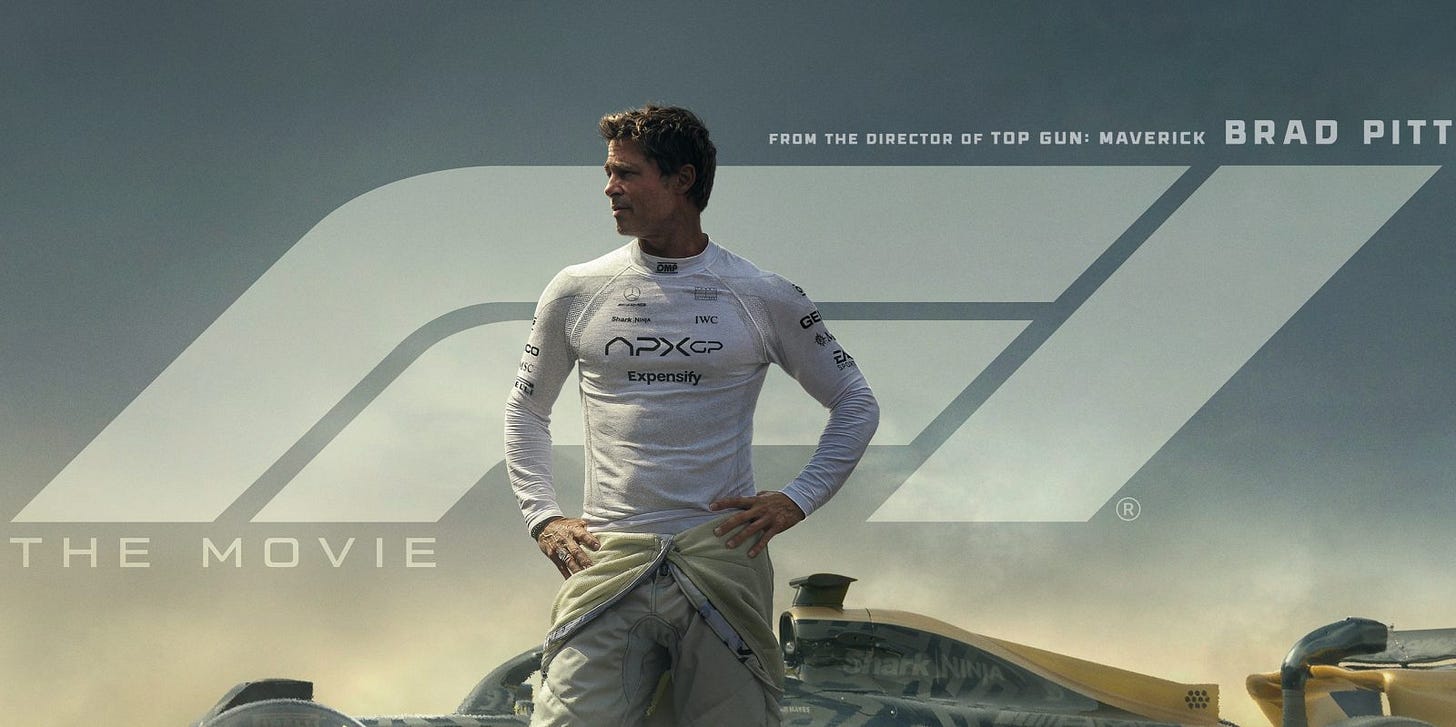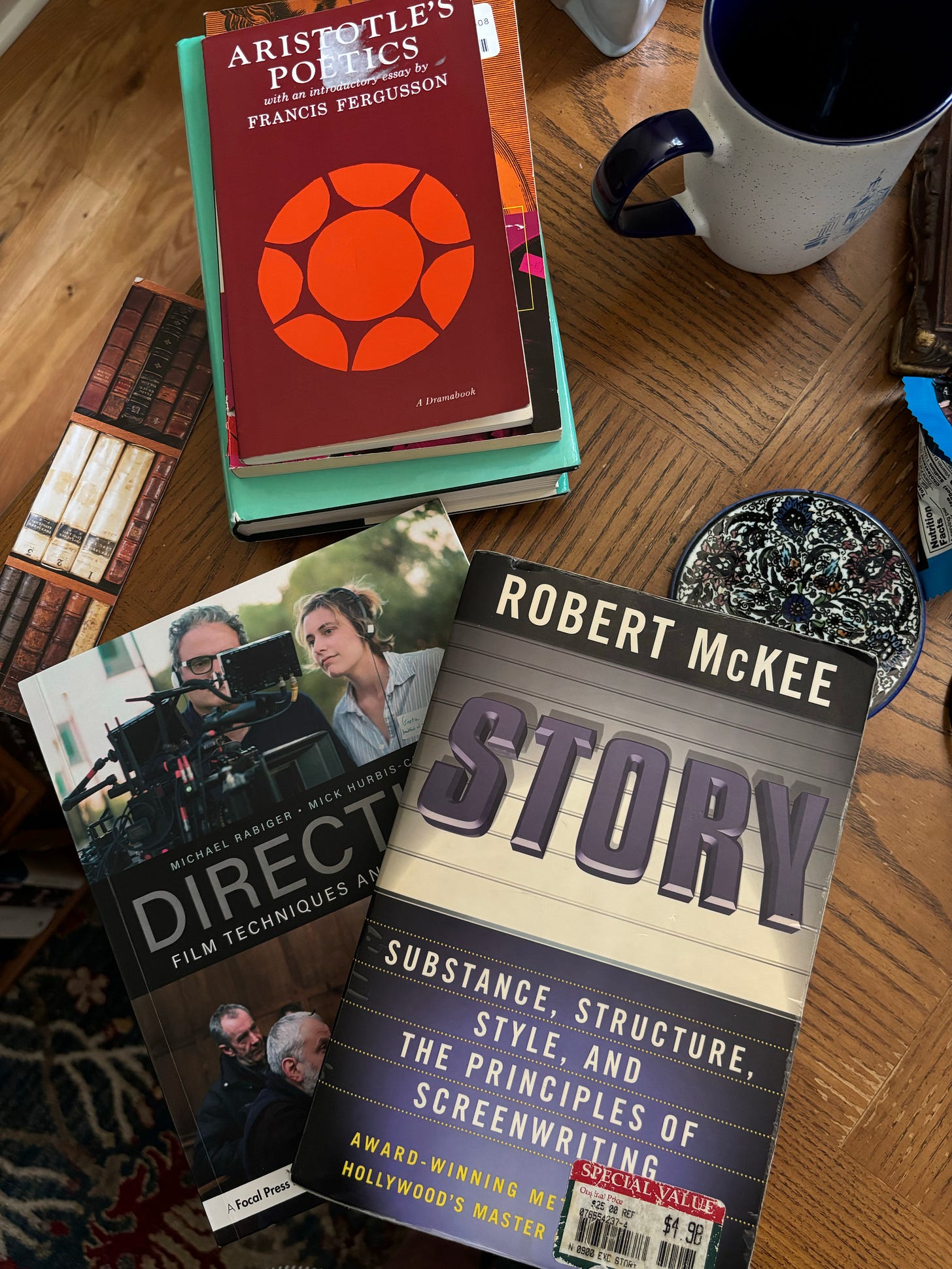5 Valuable Lessons from a Mediocre F1
A screenwriter can practice the grasp of first principles even from less-than-exemplary models
Pascal said, “The heart has its reasons that reason knows not of.”
But what are these “reasons” of the heart? How do we discover them? Live them?
These are the questions I explore in my new short audio course,
“A Brief Introduction to Poetic Experience.”
Not for poets only, but for anyone seeking to live more deeply in “being” mode rather than constantly in “doing” mode.
3 Segments. 1 Hour. A Whole New Way of Attending to Reality.
Perfect to take along on a walk, or on your commute, or while you’re doing the dishes.
Check out the details here…
Apple’s new F1 has a shiny chassis, but not much under the hood.
Which is to say: the racing scenes are extremely exciting. As my son Francis said, they are exactly what one wants from a summer popcorn movie.
But the conflicts are mostly pedestrian.
And the characterization banal.
And the dialogue? Not worth mentioning.
Nonetheless, it is a good homework exercise to study the principles of good storytelling/screenwriting on display even in a mediocre script.
Spoilers follow.
F1’s CONTROLLING IDEA
“A CONTROLLING IDEA may be expressed in a single sentence describing how and why life undergoes change from one condition of existence at the beginning to another at the end.
The Controlling Idea has two components: Value plus Cause. It identifies the positive or negative charge of the story’s critical value at the last act’s climax, and it identifies the chief reason that this value has changed to its final state. The sentence composed from these two elements, Value plus Cause, expresses the core meaning of the story.”
—Robert McKee, Story, 115.
Some people call what McKee calls the Controlling Idea the premise of a story, or its theme. its meaning, or what-the-movie-is-about.
Aristotle calls the Controlling Idea of a story its mimetic universal. I explain this term in this free excerpt from my recent interview with Ken Myers for Mars Hill Audio. (The full interview drops next week.)
Or you can go for the deeper dive in my book, Beauty & Imitation: A Philosophical Reflection on the Arts.
F1 is a sports drama. Given the genre, we should expect it to end on a positive note with the protagonist achieving victory.
Keeping in mind that the Controlling Idea is a single sentence expressing the CAUSE, i.e. the reason why, the story ends on a positive CHARGE OR VALUE at the last act’s climax, I would put the Controlling Idea of F1 this way:
A team’s F1 victory is achieved [POSITIVE VALUE] when a gutsy, seasoned maverick risks everything, including, in the end, his own personal chance at victory, to overcome the opposition [CAUSE].
The movie is a celebration of a certain understanding of courage as aggressive, high-risk, go-for-broke, sometimes even reckless behavior. With one heroic sacrifice added at the end.
WHAT IS SONNY’S RISK?
Speaking of risk:
“Here’s a simple test to apply to any story. Ask: What is the risk? What does the protagonist stand to lose if he does not get what he wants? More specifically, what’s the worst thing that will happen to the protagonist if he does not achieve his desire?
“If this question cannot be answered in a compelling way, the story is misconceived at its core.
“Life teaches that the measure of any value of any human desire [anything we deem good and desirable and fulfilling] is in direct proportion to the risk involved in its pursuit. The higher the value, the higher the risk.”
—Robert McKee, Story, 149.
So let’s ask the question of F1. What does the protagonist, Sonny Hayes (Brad Pitt), have to lose if he doesn’t get what he wants?
Several things, it seems. If Hayes doesn’t succeed in helping his team, APXGP. achieve a certain amount of success in their F1 season, then he will lose…
Self-respect
He won’t help his friend Reuben, the principal of APXGP
He might even lose his life (given a racing injury he suffered 30 years ago)
In his youth Hayes washed out as an F1 driver, and now in his 50s, after several decades of living a lonely, troubled life, he wants to redeem himself: prove to himself that he can succeed as an F1 driver at the highest level, and in the meantime help his team avoid going out of business.
THE FIRST COMBATANT
I’ve mentioned that Sonny Hayes is the protagonist of F1. The English word “protagonist” comes from two ancient Greek words: protos [first] + agonistes [combatant]. A protagonist is the first, primary, combatant in a story. There are several combatants in F1, but the story is chiefly Sonny Hayes’ fight.
“A PROTAGONIST is a willful character.
“Other characters may be dogged, even inflexible, but the protagonist in particular is a willful being….
“A fine story is not necessarily the struggle of a gigantic will versus absolute forces of inevitability. Quality of will is as important as quantity. A protagonist’s willpower may be less than the Biblical Job, but powerful enough to sustain desire through conflict and ultimately take actions that create meaningful and irreversible change.”
—Robert McKee, Story, 137.
Sonny Hayes is a most willful character. Boldness is his defining characteristic.
What does Sonny want?
More than anything else, the F1 victory that will give him self-respect.
It is Sonny’s aggressive willfulness, along with one heroic sacrifice, that is the main cause of his team’s eventual victory.
THE PRINCIPLE OF ANTAGONISM
“In my experience, the principle of antagonism is the most important and least understood precept in story design. Neglect of this fundamental concept is the primary reason screenplays and the films made from them fail”
“THE PRINCIPLE OF ANTAGONISM: A protagonist and his story can only be as intellectually fascinating and emotionally compelling as the forces of antagonism make them.
“Forces of antagonism: not necessarily an Arch-Villain, but the sum total of all forces that oppose the character’s will and desire.
“If we study a protagonist at the moment of the Inciting Incident and weigh the sum of his willpower along with his intellectual, emotional, social, and physical capacities against the total forces of antagonism from within his humanity [internal conflicts], plus his [inter]personal conflicts, antagonistic institutions, and environment [global conflict], we should see clearly that he’s an underdog. He has a chance to achieve what he wants—but only a chance. Although conflict from one aspect of his life may seem solvable, the totality of all levels should seem overwhelming as he begins his quest.”
—Robert McKee, Story, 317-18
What are the forces of antagonism Sonny Hayes and his team must face?
The specter of Sonny’s past F1 failure
Most if not all of the other F1 teams are much better than APXGP
APXGP is in deep financial debt
Sonny’s interpersonal conflict with his APXGP teammate, Joshua Pierce
Sonny’s injury not only inhibits his driving but also puts his life in jeopardy
A cunning plot to take over APXPG by Board member Peter Banning
CRISIS & CLIMAX
The strongest element of F1 is the climactic scene at the Abu Dhabi Grand Prix.
The Crisis is the ultimate decision.
“The protagonist’s quest has carried him through the Progressive Complications until he’s exhausted all actions to achieve his desire, save one. He now finds himself at the end of the line. His next action is his last. No tomorrow. No second chance. This moment of dangerous opportunity is the point of greatest tension in the story as both protagonist and audience sense that the question “How will this turn out?” will be answered out of the next action.”
—Robert McKee, Story, 303
Here’s the Wikipedia summary of Sonny’s final decision:
“During the race, Joshua takes the lead by remaining on worn tires, but is overtaken by Lewis Hamilton and Charles Leclerc; an opportune red flag is shown after a struggling Sonny, in fourth, collides with George Russell, allowing both APXGP drivers to restart on fresher tires. After passing Charles, Sonny sacrifices his chance at victory by forcing Lewis to block his overtake instead of Joshua's. However, Lewis and Joshua collide on the final lap, clearing the way for Sonny's maiden victory and blocking the sale [i.e. of the team: Peter Banning’s cunning plot].”
It is Sonny Hayes’s courage—this time in the form of heroic sacrifice—that ironically enables Sonny to achieve both his personal goal and his goal of helping APXGP win.
This ironic reversal—Sonny’s sacrifice of victory in part makes his victory possible—is a nice twist on the sports drama trope of the underdog achieving victory. Before this final reversal I was thinking, “Okay, Sonny won’t finish first himself, but he heroically makes it possible for his teammate to finish first.”
But the filmmakers nicely had one more surprise for me.
WHAT DOES F1 GET WRONG?
So many things. It would require a separate post.
No time to explain, so, as Inigo Montoya would say, I will “sum up”:
Director Joseph Kosinski and screenwriter Ehren Kruger weren’t interested in depth of characterization. No character is more than two-dimensional. The movie is about the racing, just as Top Gun: Maverick, their earlier effort, was about the flying. Both movies succeed in their action sequences.
The trope of the wizened veteran coming out of retirement for one last chance at glory is not treated in any fresh way.
The risk Sonny takes with his injury is insufficiently prepared for and developed so late in the script that it seems tacked on.
The subplot of Sonny’s pursuit of APXGP technical director Kate McKenna is puerile. Sonny is happy to “love” her and leave her, and Kate is happy to be “loved” and left.
I hope this homework assignment was helpful to you!
Your comments welcome.
What could possibly inspire the alienated and atheistic Benedict Aquila--a student at Holy Rood College, an independent, all-male Catholic boarding school in the Yorkshire Dales--to go on a four-day Easter pilgrimage to the ruined medieval abbeys of Yorkshire? Her name is Dolores. She is a student at Holy Rood’s sister school, Immaculate Heart of Mary, and with some other IHM girls, Dolores has joined the group of Holy Rood boys for the pilgrimage. But the reasons why Benedict finds Dolores attractive are inscrutable—most of all to himself. Yet she seems to Benedict to be protecting a mysterious hidden life, and in his desire to plumb that mystery, Benedict is drawn into a most surprising encounter among the ruins of Whitby Abbey—an encounter in which we can detect the spark of Benedict’s later, adult preoccupation with the renovation of ancient buildings and, more significantly, with the Shadow in that toppled sanctuary that seems both to reject and to pursue him.
“Pursuit Among the Ruins” is a new short story about the early life of Benedict Aquila, the friend of Kate Montclair from Daniel McInerny’s novel, The Good Death of Kate Montclair (Chrism Press 2023).
It’s a standalone story, however, so if you haven’t yet read the novel, that’s okay.
Paid subscribers can enjoy the entirety of “Pursuit Among the Ruins” below. The ebook is also available here on Amazon.







Really enjoyed reading your reveiw. I went for the action of the summer blockbuster action movie and I received it with much delight! Sat in a ranked theater, close to the screen, and felt I had "got my free ride" including the fireworks display! When approaching this movie, the plot expectations were secondary/incidental; it was for the 'speed of the race'. Your review provided
me with a 'second look' at the movie as it realtes to reality.
Great stuff! The character cliches definitely hampered the film when compared to the strength of the action scenes, but I also appreciated them as short had to get around the personal conflict and speed us toward the action.